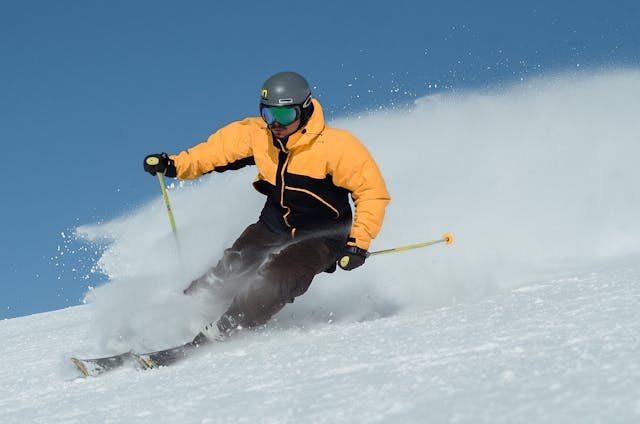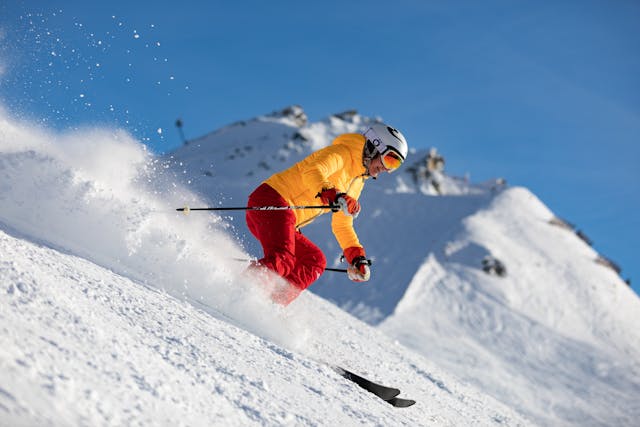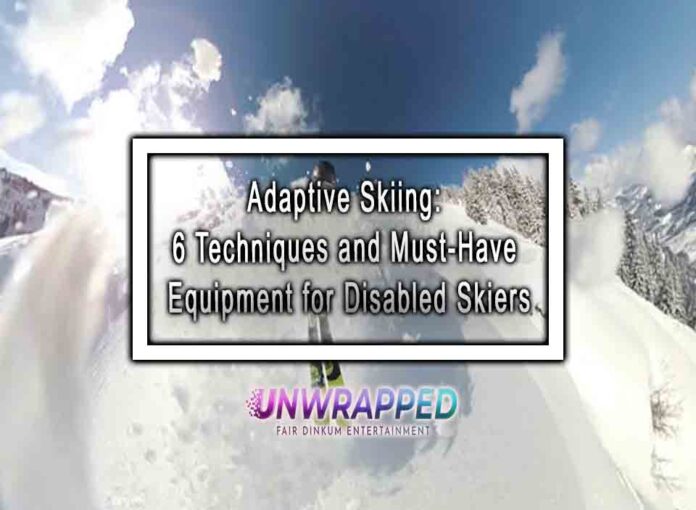Adaptive skiing has revolutionized winter sports by enabling people with physical and cognitive limitations to experience the exhilaration of sliding down snow-covered slopes. Regardless of physical limitations, adaptive skiing enables participants to experience the freedom and thrill of skiing through creative methods and specialized gear. Adaptive skiing provides customized solutions that accommodate different abilities, whether it’s using a sit ski to navigate the slopes, outriggers to learn balance, or a guide for people with vision impairments to ski. For skiers of all skill levels, this inclusive sport not only builds confidence and physical health but also a sense of belonging and community.
Six adapted skiing methods that cater to a range of demands will be covered in this guide, along with the necessary gear that allows skiers to hit the slopes in a safe and efficient manner. These developments, which range from harness systems and adaptable prosthetics to mono- and bi-skis, have completely changed the landscape of winter sports. This thorough overview offers all the information you need to enjoy the slopes with confidence, regardless of your level of experience with adaptive skiing.
Page Contents
ToggleThe Evolution of Adaptive Skiing
In order to give people with impairments access to skiing, adaptive skiing was developed in the middle of the 20th century. Adaptive skiing has become a highly specialized sport as a result of technological improvements and inclusion campaigning over time. In order to ensure that athletes of all abilities can engage in both leisure and competitive skiing, organizations such as the International Paralympic Committee and Disabled Sports USA (now Move United) have been instrumental in promoting adaptive skiing.
5 Techniques in Adaptive Skiing
Adaptive skiing employs various techniques tailored to an individual’s abilities, needs, and goals. Here’s an overview of the primary methods:
1. Sit Skiing
Sit skiing is ideal for individuals with lower-body disabilities, such as spinal cord injuries or amputations. Sit skiing involves using a mono-ski or bi-ski:
- Mono-Ski: A single ski base supports a bucket seat where the skier sits. It’s typically used by individuals with strong upper-body control.
- Bi-Ski: Designed for skiers who may need additional balance support, bi-skis have two skis under the seat.
Sit skiers steer using handheld outriggers, which double as mini-skis for balance and braking.
2. Three-Track Skiing
Three-track skiing is for individuals with one functional leg and good upper-body strength. Skiers use one regular ski and two handheld outriggers, creating a “three-track” trail in the snow. This technique is popular among amputees and individuals recovering from leg injuries.
3. Four-Track Skiing
Four-track skiing is suitable for those with limited strength or balance, such as individuals with cerebral palsy or multiple sclerosis. Skiers use two skis and two outriggers, often combined with stabilizing devices like ski bra or tethering for added control.
4. Blind or Visually Impaired Skiing
Visually impaired skiers rely on guides who communicate via radio headsets or verbal cues to navigate the slopes. The guide describes the terrain and provides instructions, allowing the skier to safely maneuver.
5. Cognitive Adaptive Skiing
This method supports individuals with cognitive disabilities, such as autism or Down syndrome. Lessons are structured with a focus on consistency, sensory management, and clear communication to build confidence and skill.

Essential Adaptive Skiing Equipment
The success of adaptive skiing hinges on specialized equipment that caters to individual needs. Here’s a breakdown of the key gear:
1. Sit Skis
- Mono-Skis: Lightweight, agile, and ideal for advanced skiers who can handle greater speed and technical challenges.
- Bi-Skis: Offer more stability and are better for beginners or individuals with less upper-body strength.
Both types of sit skis include adjustable seating, shock absorbers, and secure harnesses for comfort and safety.
2. Outriggers
Multipurpose poles with ski tips at the bottom are called outriggers. They give sit-skiers, three-trackers, and four-trackers balance, steering, and braking. Designs that may be adjusted to fit different heights and skill levels.
3. Harness Systems and Tethers
For skiers with poor balance or mobility, tethers and harnesses offer extra control. Particularly on difficult terrain, instructors or guides use tethers to steer and stabilize the skier.
4. Ski Bra
For beginners or skiers with limited strength, this device ensures better control by connecting the tips of the skis to prevent them from crossing or drifting apart.
5. Custom Prosthetics
Custom prosthetics designed for skiing provide amputee skiers more functionality and support. Greater comfort and control during high-intensity movements are made possible by specialized designs.
6. Helmet and Protective Gear
In order to reduce the danger of harm, adaptive skiers should always wear helmets and the proper padding. Safety is the top priority when skiing. Helmets designed for special adaptations are lightweight and work with communication devices or hearing aids.
Getting Started with Adaptive Skiing
1. Finding the Right Program
Numerous ski areas have adaptive skiing programs with qualified instructors and suitable gear. People can find local services and programs that are suited to their requirements through organizations like Adaptive Adventures and Move United.
2. Working with Certified Instructors
Qualified adaptive ski instructors are equipped with the knowledge and expertise to design courses that are tailored to each student’s physical and mental capabilities. To gain confidence, lessons frequently start on mild slopes before moving on to more difficult terrain.
3. Building Strength and Endurance
Strength training and conditioning are advantageous because adaptive skiing can be physically taxing. Exercises that increase stamina, core strength, and balance include yoga, swimming, and wheelchair workouts.
Overcoming Challenges
Adaptive skiing isn’t without its challenges. Here’s how to address common barriers:
1. Cost of Equipment
Specialized equipment might be costly. To make skiing accessible, a number of adaptive sports groups provide rental programs or financial aid.
2. Accessibility at Resorts
Not every ski area is completely reachable. Examine facilities to make sure they have skilled personnel, accessible lodging, and adaptive skiing programs.
3. Fear of Injury
Injury risks are reduced by appropriate training, protective clothing, and collaboration with professional instructors. To gradually gain confidence, start off slowly and give technique top priority.

Spotlight on Competitive Adaptive Skiing
Athletes with physical and cognitive limitations demonstrate extraordinary skill and perseverance in competitive adapted skiing, an exciting and motivating part of winter sports. Adaptive skiers compete in the Paralympic Games in events such para-snowboarding, downhill, super-G, giant slalom, and slalom. Because athletes are categorized according to their functional abilities, competitors can compete against other athletes who possess comparable skills. From sit-skis and prosthetics to cutting-edge outriggers and harness systems, these competitions showcase the adaptive methods and specialized gear that allow athletes to compete at their best. In addition to advancing adaptive skiing, the competitive scene offers a potent forum for advancing diversity and dismantling obstacles in athletics.
For athletes, competitive adaptive skiing can be a transformative experience that offers chances for recognition, personal development, and even qualification for international events. Numerous adaptive ski programs give athletes the tools and guidance they need to improve their abilities, compete, and reach their greatest potential. The emergence of adaptive skiing contests has greatly increased awareness by demonstrating that willpower and the appropriate gear may enable disabled sportsmen to accomplish remarkable feats on the slopes, encouraging upcoming generations to take on challenges in the adaptive sports space.
Resources for Adaptive Skiers
Here are some organizations and programs that support adaptive skiing:
- Move United: Offers nationwide resources and adaptive sports programs.
- National Sports Center for the Disabled (NSCD): Based in Colorado, NSCD provides adaptive skiing lessons and equipment.
- Winter Sports Foundation: Promotes snow sports for people with disabilities, including training for competitive skiing.
Ending Thoughts
Adaptive skiing is a prime example of the strength of creativity and perseverance, demonstrating that people of all abilities can enjoy winter sports. Disabled skiers can enjoy the thrill of confidently and controllably gliding down the slopes by adopting one of the six adaptive skiing styles and using essential equipment designed to meet their needs. These specialized equipment, which range from harness systems and visual aids to sit skis and outriggers, not only improve safety but also create new opportunities for adventure, fitness, and personal development.
Adaptive skiing presents a special chance to push limits and develop a sense of accomplishment, regardless of your prior experience or ability level. It’s a celebration of inclusivity, community, and resiliency rather than just a pastime. Everyone can embrace the life-changing experience of skiing and make enduring memories on the snowy slopes with the correct instruction, gear, and assistance.
See Also: The Evolution of Wheelchair Basketball: From Rehabilitation to Paralympic Sport










